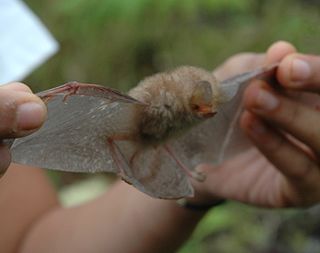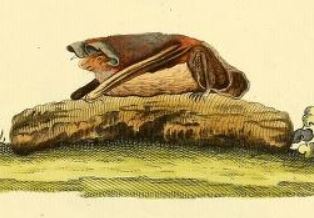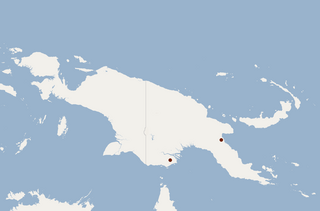
The New Guinea big-eared bat or Papuan big-eared bat,, is a vesper bat endemic to Papua New Guinea. It is listed as a critically endangered species due to ongoing habitat loss. It is the only known member of the genus Pharotis, which is closely related to Nyctophilus.

The eastern long-eared bat, species Nyctophilus bifax, is a small flying mammal, a vespertilionid bat. It is found in eastern Australia and Papua New Guinea.

The small-toothed long-eared bat is a species of vespertilionid bat found only in Papua New Guinea.
St. Aignan's trumpet-eared bat is a species of vesper bat in the family Vespertilionidae. It is found only in Papua New Guinea, and is only endemic to the islands, not the mainland. The species has been recorded on the islands of Fergusson, Vanatinai, Woodlark, and Misima. Its natural habitat is subtropical or tropical dry forests.
The Damara woolly bat is a nocturnal insectivorous species of vesper bat in the family Vespertilionidae found in Africa. This species typically has reddish brown fur on its back and white fur on its abdomen. Its natural habitat is moist savanna, although it has also been shown to inhabit woodlands and coastal forests. These bats typically weight about 10 g, and have a low aspect ratio, as well as low wing loading.

The lesser woolly bat is a species of vesper bat in the family Vespertilionidae. It is found in Botswana, Central African Republic, Democratic Republic of the Congo, Ivory Coast, Ethiopia, Gabon, Ghana, Guinea, Kenya, Liberia, Malawi, Nigeria, South Africa, Tanzania, Zambia, Zimbabwe and rarely Ethiopia. Its natural habitats are subtropical or tropical moist lowland forests, dry savanna, and moist savanna. Members of this species typically have a dark greyish brown fur with whitish tips scattered throughout.
The Fly River trumpet-eared bat is a species of vesper bat in the family Vespertilionidae. It is found only in Papua New Guinea. Its natural habitat is subtropical or tropical dry forests.

The clear-winged woolly bat is a species of vesper bat in the family Vespertilionidae. It is found in Brunei, Indonesia, Malaysia, and the Philippines. Members of this species are relatively small, typically weighing about 4.5g and mainly forages in the understory of tropical forests. This species also presents a unique variant of echolocation that is a higher intensity and lower frequency than most other kerivoula calls. The sort range calls are distinguishable from the long range orientational echolocation calls by peak frequency and duration.

The painted bat or painted wooly bat is a species of vesper bat in the family Vespertilionidae. It is also known as "butterfly bat", "rongin chamchika" or "komola-badami chamchika" in Bengali.

The golden-tipped bat is a species of Microchiropteran in the family Vespertilionidae. It is found in Papua New Guinea and in Australia, especially scattered along the eastern part of Australia. The species is considered uncommon, and is listed as endangered in Australia.
The lenis woolly bat is a species of bat in the family Vespertilionidae. It is found in South and Southeast Asia.

Kerivoula is a genus of vesper bats in the subfamily Kerivoulinae. They are found throughout tropical and subtropical regions of Africa, Asia, and New Guinea.

Kerivoulinae is a subfamily of vesper bats. There are 25 species in 2 genera within this subfamily:

Nyctophilus is a genus of the vespertilionids or vesper bats. They are often termed Australian big-eared bats or long-eared bats, as the length of their ears often greatly exceeds that of the head. This genus occurs in the New Guinean-Australian region.

Andersen's naked-backed fruit bat or Andersen's bare-backed fruit bat is a large cave-dwelling species of megabat in the family Pteropodidae. It is endemic to the Bismarck Archipelago including the Admiralty Islands in Papua New Guinea.
Nyctophilus daedalus is a species of bat in the family Vespertilionidae, a flying mammal endemic to northern Australia. They are also referred to as the pallid long-eared bat or northern long-eared bat.

The Mount Missim long-eared bat is a species of vesper bat found in Papua New Guinea.











